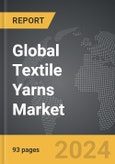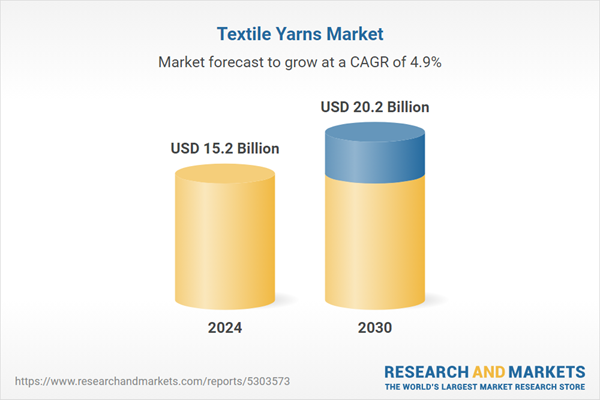The global market for Textile Yarns was valued at US$15.2 Billion in 2024 and is projected to reach US$20.2 Billion by 2030, growing at a CAGR of 4.9% from 2024 to 2030. This comprehensive report provides an in-depth analysis of market trends, drivers, and forecasts, helping you make informed business decisions. The report includes the most recent global tariff developments and how they impact the Textile Yarns market.
Segments: Type (Artificial, Natural); Application (Home Textile, Apparel, Industrial, Other Applications).
Geographic Regions/Countries: World; United States; Canada; Japan; China; Europe (France; Germany; Italy; United Kingdom; Spain; Russia; and Rest of Europe); Asia-Pacific (Australia; India; South Korea; and Rest of Asia-Pacific); Latin America (Argentina; Brazil; Mexico; and Rest of Latin America); Middle East (Iran; Israel; Saudi Arabia; United Arab Emirates; and Rest of Middle East); and Africa.
The analysts continuously track trade developments worldwide, drawing insights from leading global economists and over 200 industry and policy institutions, including think tanks, trade organizations, and national economic advisory bodies. This intelligence is integrated into forecasting models to provide timely, data-driven analysis of emerging risks and opportunities.
Global Textile Yarns Market - Key Trends and Drivers Summarized
How Are Textile Yarns Supporting Versatility in Fabric Production?
Textile yarns are continuous strands of fibers or filaments twisted or spun together to create a material suitable for weaving, knitting, or other textile manufacturing processes. They are the building blocks of fabrics and come in various types, including natural, synthetic, and blended yarns, supporting a wide range of applications in apparel, home textiles, technical textiles, and industrial fabrics. As the demand for different fabric textures, strengths, and properties grows, textile yarns play a crucial role in meeting diverse production requirements and achieving high-quality outputs.What Are the Key Segments in the Textile Yarns Market?
Key types include natural yarns (cotton, wool, silk), synthetic yarns (polyester, nylon, acrylic), and blended yarns, with synthetic yarns holding the largest market share due to their cost-effectiveness, durability, and wide range of applications. Applications cover apparel, home textiles, technical textiles, and industrial fabrics, with apparel representing a significant segment driven by the demand for versatile yarns that provide comfort, durability, and aesthetic appeal. End-users include apparel manufacturers, home furnishing companies, and technical textile producers, with apparel manufacturers dominating the market as they require a broad range of yarns to produce diverse clothing items.How Are Textile Yarns Integrated Across Fabric Manufacturing?
In apparel production, textile yarns are used to create fabrics for casual wear, sportswear, formal wear, and fashion textiles, offering different properties like stretchability, softness, and moisture management. In home textiles, yarns contribute to the production of bed linens, curtains, and carpets, providing aesthetic appeal, comfort, and durability. For technical textiles, specialized yarns offer properties like high tensile strength, flame resistance, and moisture wicking, supporting applications in automotive interiors, protective gear, and medical textiles. Additionally, in industrial fabrics, yarns ensure strength and stability in products like conveyor belts, filtration fabrics, and geotextiles, enhancing performance in heavy-duty environments.What Factors Are Driving the Growth in the Textile Yarns Market?
The growth in the Textile Yarns market is driven by several factors, including increasing demand for versatile and high-quality fabrics, advancements in yarn spinning technologies, and expanding applications in technical textiles. Innovations like bio-based yarns, improved fiber blends, and enhanced spinning techniques have supported broader applications in modern fabric production. The focus on improving fabric performance, achieving cost efficiency, and ensuring sustainability in textiles has further fueled demand, as textile yarns offer essential benefits in diverse manufacturing processes. Additionally, growing apparel production, rising home textile consumption, and expanding technical textile applications have contributed to market growth, encouraging the use of innovative yarns across sectors.Report Scope
The report analyzes the Textile Yarns market, presented in terms of units. The analysis covers the key segments and geographic regions outlined below.Segments: Type (Artificial, Natural); Application (Home Textile, Apparel, Industrial, Other Applications).
Geographic Regions/Countries: World; United States; Canada; Japan; China; Europe (France; Germany; Italy; United Kingdom; Spain; Russia; and Rest of Europe); Asia-Pacific (Australia; India; South Korea; and Rest of Asia-Pacific); Latin America (Argentina; Brazil; Mexico; and Rest of Latin America); Middle East (Iran; Israel; Saudi Arabia; United Arab Emirates; and Rest of Middle East); and Africa.
Key Insights:
- Market Growth: Understand the significant growth trajectory of the Artificial segment, which is expected to reach US$12.5 Billion by 2030 with a CAGR of a 5.1%. The Natural segment is also set to grow at 4.6% CAGR over the analysis period.
- Regional Analysis: Gain insights into the U.S. market, valued at $4.0 Billion in 2024, and China, forecasted to grow at an impressive 7.5% CAGR to reach $4.4 Billion by 2030. Discover growth trends in other key regions, including Japan, Canada, Germany, and the Asia-Pacific.
Why You Should Buy This Report:
- Detailed Market Analysis: Access a thorough analysis of the Global Textile Yarns Market, covering all major geographic regions and market segments.
- Competitive Insights: Get an overview of the competitive landscape, including the market presence of major players across different geographies.
- Future Trends and Drivers: Understand the key trends and drivers shaping the future of the Global Textile Yarns Market.
- Actionable Insights: Benefit from actionable insights that can help you identify new revenue opportunities and make strategic business decisions.
Key Questions Answered:
- How is the Global Textile Yarns Market expected to evolve by 2030?
- What are the main drivers and restraints affecting the market?
- Which market segments will grow the most over the forecast period?
- How will market shares for different regions and segments change by 2030?
- Who are the leading players in the market, and what are their prospects?
Report Features:
- Comprehensive Market Data: Independent analysis of annual sales and market forecasts in US$ Million from 2024 to 2030.
- In-Depth Regional Analysis: Detailed insights into key markets, including the U.S., China, Japan, Canada, Europe, Asia-Pacific, Latin America, Middle East, and Africa.
- Company Profiles: Coverage of players such as Birleþik Koyunlulular Mensucat TIC. V.E SAN. A.Þ., Grasim Industries Limited., Hengli Group, Huvis Corporation, Kairuide Hulding Co Ltd. and more.
- Complimentary Updates: Receive free report updates for one year to keep you informed of the latest market developments.
Some of the 37 companies featured in this Textile Yarns market report include:
- Birleþik Koyunlulular Mensucat TIC. V.E SAN. A.Þ.
- Grasim Industries Limited.
- Hengli Group
- Huvis Corporation
- Kairuide Hulding Co Ltd.
- Low & Bonar Plc.
- Parkdale Mills Incorporated
- Raymond Limited
- Vardhman Textiles Limited
- Weiqiao Textile Company Limited
Tariff Impact Analysis: Key Insights for 2025
Global tariff negotiations across 180+ countries are reshaping supply chains, costs, and competitiveness. This report reflects the latest developments as of April 2025 and incorporates forward-looking insights into the market outlook.The analysts continuously track trade developments worldwide, drawing insights from leading global economists and over 200 industry and policy institutions, including think tanks, trade organizations, and national economic advisory bodies. This intelligence is integrated into forecasting models to provide timely, data-driven analysis of emerging risks and opportunities.
What’s Included in This Edition:
- Tariff-adjusted market forecasts by region and segment
- Analysis of cost and supply chain implications by sourcing and trade exposure
- Strategic insights into geographic shifts
Buyers receive a free July 2025 update with:
- Finalized tariff impacts and new trade agreement effects
- Updated projections reflecting global sourcing and cost shifts
- Expanded country-specific coverage across the industry
Table of Contents
I. METHODOLOGYII. EXECUTIVE SUMMARY2. FOCUS ON SELECT PLAYERSIII. MARKET ANALYSISSOUTH KOREAREST OF ASIA-PACIFICARGENTINABRAZILMEXICOREST OF LATIN AMERICAIRANISRAELSAUDI ARABIAUNITED ARAB EMIRATESREST OF MIDDLE EASTIV. COMPETITION
1. MARKET OVERVIEW
3. MARKET TRENDS & DRIVERS
4. GLOBAL MARKET PERSPECTIVE
UNITED STATES
CANADA
JAPAN
CHINA
EUROPE
FRANCE
GERMANY
ITALY
UNITED KINGDOM
SPAIN
RUSSIA
REST OF EUROPE
ASIA-PACIFIC
AUSTRALIA
INDIA
LATIN AMERICA
MIDDLE EAST
AFRICA
Companies Mentioned (Partial List)
A selection of companies mentioned in this report includes, but is not limited to:
- Birleþik Koyunlulular Mensucat TIC. V.E SAN. A.Þ.
- Grasim Industries Limited.
- Hengli Group
- Huvis Corporation
- Kairuide Hulding Co Ltd.
- Low & Bonar Plc.
- Parkdale Mills Incorporated
- Raymond Limited
- Vardhman Textiles Limited
- Weiqiao Textile Company Limited
Table Information
| Report Attribute | Details |
|---|---|
| No. of Pages | 93 |
| Published | April 2025 |
| Forecast Period | 2024 - 2030 |
| Estimated Market Value ( USD | $ 15.2 Billion |
| Forecasted Market Value ( USD | $ 20.2 Billion |
| Compound Annual Growth Rate | 4.9% |
| Regions Covered | Global |









